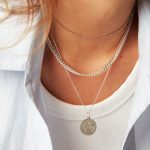The History of Necklaces
The history of necklaces is as ancient as human civilization itself. Each era witnessed unique designs and materials, reflecting cultural values and technological advancements. Let find necklace definition.
Prehistoric Times and Ancient Civilizations
In prehistoric times, necklaces were made from natural materials like bones, teeth, and shells. Early humans used necklaces for protection and to show status. Ancient Egyptians heightened the necklace definition with gold and lapis lazuli, signifying power and divine favor.
Middle Ages to the Renaissance
During the Middle Ages, necklaces evolved as symbols of wealth and class. Nobles flaunted necklaces adorned with precious metals and gemstones. The Renaissance sparked an appreciation for art, with necklaces becoming more intricate and decorative.
The Modern Era and Contemporary Designs
The modern era ushered in a range of styles. From the simple, elegant pearl necklace to bold, avant-garde pieces, necklaces now reflect personal taste and fashion. Today’s designers often blend classic elements with modern materials, ensuring the necklace’s continued relevance and appeal.
Materials and Craftsmanship
Necklaces are not just pieces of jewelry but a blend of art and science. The materials and craftsmanship define the beauty, value, and durability of a necklace. Let’s explore what goes into creating these adornments.
Precious Metals
Gold, silver, and platinum rank among the most desired metals for necklaces. Gold offers a classic appeal and comes in various purities, such as 22K, 18K, 14K, and 10K. Silver, known for its reflective surface, is affordable and versatile. Platinum stands out for its strength and longevity, making it a premium choice for heirloom pieces. Master jewelers shape these metals into delicate chains, clasps, and pendants with precision and skill.
Gemstones and Beads
Gemstones elevate a necklace’s elegance with their color and rarity. Diamonds, rubies, sapphires, and emeralds are highly sought after for their sparkle and hue. Beads offer diversity from pearls, glass, wood, to semi-precious stones. Each bead is carefully selected and threaded to create intricate patterns and delightful textures.
Non-Traditional Materials
Innovation in necklace materials continues to grow. Designers use textiles, ceramics, acrylics, and even recycled items to craft unique necklaces. These non-traditional materials allow for endless creativity, affordability, and eco-friendly options. Necklaces made from alternative materials can provide the same visual impact as precious metals and gems, proving that value lies not just in the materials but in the creativity of the design.

Types of Necklaces
There are many types of necklaces, each with its own unique appeal and history. From snug chokers to loose, flowing multi-strands, necklaces can be tailored to fit any style and occasion.
Chokers
Chokers are close-fitting necklaces worn around the neck. This necklace definition includes a wide variety of designs, from simple ribbons to elaborate pieces adorned with jewels. Often associated with high fashion, chokers can accentuate the elegance of the neck and add a bold statement to an ensemble.
Pendant Necklaces
Pendant necklaces feature a hanging ornament suspended from a chain or cord. The pendant is often the focal point and comes in countless shapes and styles. It can be a single diamond, a precious stone, or a personalized charm that adds meaning to the necklace.
Chains and Links
Chains are the backbone of many necklace styles, created by interlocking metal links. They can be worn alone for a simplistic look or serve as the base for attaching pendants and charms. Styles vary from delicate, fine chains to larger, more statement-making links.
Layered and Multi-Strand Necklaces
Layered necklaces combine multiple strands of various lengths worn together to create depth and complexity. Multi-strand necklaces, on the other hand, consist of several strands attached at the clasp, providing a voluminous look. Both types offer a way to mix textures and materials, often incorporating beads, metals, and gems.
Symbolism and Cultural Significance
Necklaces hold more than just decorative value; they carry deep symbolism and cultural significance. Across time, necklaces have been a canvas for expressing beliefs, showcasing status, and reflecting fashion trends.
Religious and Spiritual Meanings
Necklaces often serve as vessels for religious and spiritual symbols. For instance, a cross pendant represents faith in Christianity. Similarly, Hinduism uses necklaces with symbols like the ‘Om’ to convey spirituality. These religious necklaces can offer protection, serve as a reminder of spiritual commitment, or act as a tool for meditation.
Status and Wealth Indicators
Throughout history, necklaces have acted as markers of status and wealth. Think of the ancient Pharaohs, adorned with gold and precious stones, displaying their power. In many cultures, wearing a necklace made from rare materials is a clear indicator of one’s social standing. Even today, a necklace with diamonds or other precious gemstones can signify affluence and prestige.
Fashion and Personal Expression
Necklaces are also a form of personal expression, reflecting individual style and fashion sensibilities. They vary from bold statement pieces that command attention to subtle designs meant to complement an outfit. Modern necklace definition has expanded to include self-expression, with individuals choosing necklaces that represent their personality, interests, or even life events.

How to Choose the Right Necklace
Choosing the right necklace is essential to complement your style and appearance. This guide will help you understand key factors in selecting the perfect necklace for any occasion.
Understanding Neck Size and Length
Finding the correct necklace length is crucial for comfort and style. Measure your neck’s circumference with a flexible tape. Add two inches to this measurement for a comfortable choker fit. For a slightly longer look, such as a princess length, aim for 17 to 19 inches. Understanding neck size and necklace lengths helps you select pieces that sit well and enhance your outfit.
Matching Necklaces with Outfit Styles
The secret to completing an outfit is pairing it with the appropriate necklace. For V-neck tops, choose pendant necklaces that mirror the neckline. High necklines pair well with longer chains or layered necklaces. With strapless dresses, consider chokers to draw attention to your neck and shoulders. Keep the necklace definition in sync with your outfit to create a polished look.
Selecting Necklaces for Different Occasions
Different occasions call for different necklace styles. For formal events, opt for elegant pearl necklaces or those with precious gemstones. Casual outings might invite more playful and colorful bead necklaces. Work environments usually favor subtle, understated pieces. Remember, the right necklace not only matches the occasion but also complements your personal style.
Care and Maintenance of Necklaces
Proper care for necklaces preserves their beauty and extends their life. This includes regular cleaning, correct storage, and precautions to prevent damage.
Cleaning and Storing Different Materials
Clean gold with a soft cloth and warm soapy water. Dry it with care. Store gold necklaces separately to avoid scratches. Silver necklaces need a gentle polish to maintain shine. Use a silver cleaning solution or cloth. Store them in airtight bags with anti-tarnish strips to keep them bright. For pearl necklaces, use a damp cloth. Avoid chemicals, they can damage the pearls. Store pearls flat to prevent stretching.
Preventing Tarnish and Damage
To prevent tarnish, keep necklaces away from chemicals like perfume and chlorine. Remove necklaces before swimming or showering. When not in use, keep your necklaces in a cool, dry place. Wrap them in soft cloth or place them in padded jewelry boxes.
Professional Repair and Restoration
If a necklace breaks, seek a professional jeweler for repair. They have the tools and skills needed for intricate fixes. For heirloom or expensive pieces, professional cleaning can restore original luster. They can also advise on care tips for specific necklace definitions and materials.

The Impact of Technology on Necklace Design
Technology has reshaped many industries, and jewelry making is no exception. Advances in technology have introduced new methods for crafting necklaces, changing the necklace definition of artisanry.
Innovations in Jewelry Making
Jewelers now harness cutting-edge tools to create intricate designs that were once impossible. Laser cutting allows for precise cuts and patterns in metal. Computer-aided design (CAD) lets designers visualize pieces before creation. These technologies mean higher quality and more complex necklace designs.
Modern metallurgy has produced new metal alloys. These alloys offer durability and unique colors for necklaces. They broaden the range of materials jewelers can use.
Innovations also include improved gemstone cutting techniques. These techniques enhance the stones’ brilliance and impact in necklaces. New setting methods secure gemstones better. They reduce the risk of losing them with regular wear.
The Rise of Customizable and 3D Printed Necklaces
Customization in necklaces has soared with technology. Customers now play a part in designing their unique pieces. Jewelers can edit designs quickly and efficiently using software. This customization lets buyers express their individual styles in new ways.
3D printing is a revolutionary stride in necklace making. This method allows for intricate, bespoke designs at a reduced cost. 3D printed necklaces can include complex geometries. These are tough to achieve by traditional methods. This technology has made once-exclusive designs more accessible.
Most notably, 3D printing permits eco-friendly practices. Jewelers can use biodegradable materials or recycled metals. This tech maintains the necklace definition of luxury while reducing waste.
Technology will continue to redefine our understanding of necklaces. It creates opportunities for innovation and personal expression in jewelry design.


